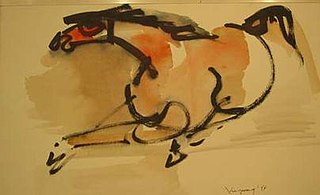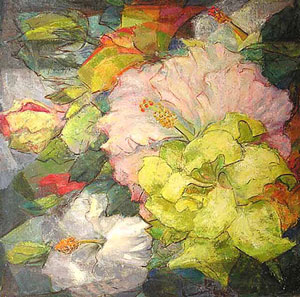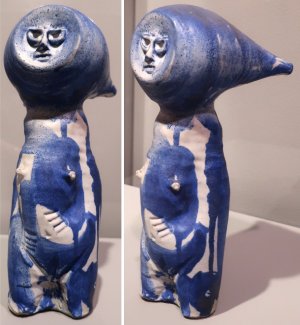
The University of Hawaiʻi at Mānoa is a public land-grant research university in Mānoa, a neighborhood of Honolulu, Hawaii. It is the flagship campus of the University of Hawaiʻi system and houses the main offices of the system. Most of the campus occupies the eastern half of the mouth of Mānoa Valley, with the John A. Burns School of Medicine located adjacent to the Kakaʻako Waterfront Park.

The Honolulu Museum of Art is an art museum in Honolulu, Hawaiʻi. The museum is the largest of its kind in the state, and was founded in 1922 by Anna Rice Cooke. The museum has one of the largest single collections of Asian and Pan-Pacific art in the United States, and since its official opening on April 8, 1927, its collections have grown to more than 55,000 works of art.
Toshiko Takaezu was an American ceramic artist, painter, sculptor, and educator who was known for her rounded, closed forms that viewed ceramics as a fine art and more than a functional vessel. She is of Japanese descent and from Pepeeko, Hawaii.

Hiroki Morinoue is an American artist of Japanese descent who has helped to pioneer in the United States the fusion of western Impressionism with modern Japanese design.

The Hawaiian archipelago consists of 137 islands in the Pacific Ocean that are far from any other land. Polynesians arrived there one to two thousand years ago, and in 1778 Captain James Cook and his crew became the first Europeans to visit Hawaii. The art created in these islands may be divided into art existing prior to Cook’s arrival; art produced by recently arrived westerners; and art produced by Hawaiians incorporating western materials and ideas. Public collections of Hawaiian art may be found at the Honolulu Museum of Art, the Bishop Museum (Honolulu), the Hawaii State Art Museum and the University of Göttingen in Germany.

John Chin Young 容澤泉 (1909–1997) was a painter who was born in Honolulu, Hawaii on March 26, 1909. He was the son of Chinese immigrants and began drawing at the age of eight, stimulated by Chinese calligraphy, which he learned in Chinese language school. Young had his first and only art lessons while a student at President William McKinley High School in Honolulu. Thereafter, his art was entirely self-taught. Young is best known for his Zen-like depictions of horses, paintings of children, and abstractions. Over the years, he acquired an important collection of ancient Asian art, which he donated to the Honolulu Museum of Art and the University of Hawaii at Manoa as the John Young Museum. John Chin Young died in 1997 at the age of 88. His daughter Debbie Young is also a painter residing in Hawaii.

Hon Chew Hee was an American muralist, watercolorist and printmaker who was born in Kahului, on the Hawaiian island of Maui in 1906. He grew up in China, where he received his early training in Chinese brush painting. He returned to the United States in 1920 at age 14 in order to further his training at the San Francisco Art Institute, receiving that school's highest academic honor. He then taught in China until moving to Hawaii in 1935. In Hawaii, he worked as a freelance artist and held classes in both Western and Eastern styles of painting. Together with Isami Doi (1903–1965), Hee taught painting classes at the YMCA. At this time, Doi instructed the young artist in woodcarving techniques and Hee, like his master, created wood engravings drawn from the rural life in the Islands. Hee also founded the Hawaii Watercolor and Serigraph Society.

Shirley Ximena Hopper Russell, also known as Shirley Marie Russell, was an American artist best known for her paintings of Hawaii and her still lifes of Hawaiian flowers. She was born Shirley Ximena Hopper in Del Rey, California, in 1886. She graduated in 1907 from Stanford University, where she discovered art. Shirley married Lawrence Russell, an engineer, in 1909. When he died in 1912, she began teaching in Palo Alto, and dabbling in painting. In 1921, she and her son came to Hawaii for a visit and decided to stay. She studied under Hawaiian artist Lionel Walden during the 1920s and traveling to Europe several times to further her art education. She studied in Paris during the 1930s and the cubist influence can be seen in a number of her works. She taught art at President William McKinley High School in Honolulu for more than 20 years. Around 1935-1936, the Japanese publisher Watanabe Shozaburo (1885–1962) published more than several woodblock prints she designed. The majority of these prints depict colorful and detailed tropical flowers, while at least one print, Carmel Mission, is a California landscape.

Juliette May Fraser was an American painter, muralist and printmaker. She was born in Honolulu, which was then the capital city of the Kingdom of Hawaii. After graduating from Wellesley College with a degree in art, she returned to Hawaii for several years. She continued her studies with Eugene Speicher and Frank DuMond at the Art Students League of New York and at the John F. Carlson School of Landscape Painting in Woodstock, New York. She returned to Hawaii to teach, like her parents who had both come to Hawaii as educators. Fraser designed the Hawaii Sesquicentennial half dollar, which was engraved by Chester Beach and issued in 1928.

Satoru Abe is a Japanese American sculptor and painter.

Louis Pohl was an American painter, illustrator, art teacher, printmaker and cartoonist. He was born in Cincinnati, Ohio in 1915. A childhood illness made it impossible to walk without pain and prevented Pohl from entering school until he was 8 years old. To keep him occupied, his parents would give him papers and pencils with which to draw. When 14 years old, Pohl spent his summer caddying at a local golf course. A regular foursome of well-to-do women made an unusual wager—the loser would make their caddy's wish come true. Mrs. Yaeger paid for Pohl's tuition at the Art Academy of Cincinnati for two years. He spent the next 4 years as a teacher's assistant. He did most of the hands-on teaching given to the art students, and he also taught art to underprivileged kids on Saturdays. Eventually, Pohl received his certificate of art upon the completion of a full standing nude copy of a Rembrandt that hung in the Cincinnati Art Museum.

Bumpei Akaji (1921–2002) was an American sculptor from Hawaii. He was known for welding large copper and brass sculptures which can be seen all over Hawaii as part of Hawaii's Art in Public Places program.

Alan Leitner is an American abstract artist. He was born in 1947 in an ethnically diverse section of Los Angeles. Alan was the middle of three children in a Jewish family. He received his B.S. in art in 1971 from Woodbury University in Los Angeles, where he met his first wife who wanted to move to Hawaii. Also in 1971, he acquired an art foundry that produced blown glass, sculpture, ceramics and paintings, which contributed greatly to his understanding of art. In 1987, he received a M.F.A. in painting from the University of Hawaii at Manoa. The graduate program required students to do some teaching, and through this teaching he met Alyn Brownley who at the time headed the art program at Leeward Community College. Brownley requested Alan to teach her art class for one semester while she pursued a move to University of Hawaii at Manoa. After graduation, Dr. John Conner, the department associate dean, offered Alan a full-time teaching position at Leeward Community College, where he is currently a professor. Alan has also taught at Honolulu Community College and University of Hawaii at Manoa.

The No. 1 Capitol District Building, on the site of the former Armed Services YMCA Building, now houses the Hawaiʻi State Art Museum and the Hawaii State Foundation on Culture and the Arts.
Tetsuo Ochikubo (1923–1975), also known as Bob Ochikubo, was a Japanese-American painter, sculpture, and printmaker who was born in Waipahu, Hawaii, Honolulu county, Hawaii. During the Second World War, he served with the 100th Battalion of the 442nd Regimental Combat Team. After being discharged from the Army, he studied painting and design at the School of the Art Institute of Chicago and at the Art Students League of New York. In 1953, he spent a year in Japan, studying traditional brush painting and connecting with his ancestry. He worked at Tamarind Institute in the 1960s and is best known for his entirely abstract paintings and lithographs. Along with Satoru Abe, Bumpei Akaji, Edmund Chung, Jerry T. Okimoto, James Park, and Tadashi Sato, Ochikubo was a member of the Metcalf Chateau, a group of seven Asian-American artists with ties to Honolulu. Ochikubo died in Kawaihae, Hawaii in 1975.
Esther Shimazu is an American sculptor who was born in Honolulu, Hawaii in 1957. Her grandparents were immigrant laborers from Japan. She attended the University of Hawaii at Manoa before transferring to the University of Massachusetts in Amherst, where she received a Bachelor of Fine Art in 1980 and a Master of Fine Art in 1982.
David Kuraoka is an American ceramic artist. He was born in Lihue, Hawaii, grew up on the island of Kauai, Hawaii in Hanamaulu and Lihue, and graduated from Kauai High School in 1964. Kuraoka spent his formative years in Hanamaulu where he lived with his parents in his paternal grandmother's home in a plantation labor camp. His father, one of seven children and the only son, became a journalist, writing a weekly column published on Wednesdays, and the Kauai campaign manager for local politician Hiram Fong and Richard Nixon. His mother, Emiko Kuraoka, was a school teacher. He is married to Carol Kuraoka. Kuraoka moved to California in 1964 to study architecture at San Jose City College, eventually transferring to San José State University where he received his BA in 1970 and MA 1971. After completing graduate work that focused on ceramics, Kuraoka joined the faculty at San Francisco State University, eventually rising to head its ceramics department.
Rick Mills is an American glass artist who was born and raised in Marion, Ohio. He received his bachelor of fine art degree in sculpture from Ohio State University, where the art department reopened its glass program in 1980, during Mills last semester. He moved to Hawai'i in 1981 and earned a master of fine art degree, also in sculpture, from the University of Hawaiʻi at Mānoa, where he is currently professor and director of the glass art program.

Claude Horan was an American ceramic and glass artist who was born in Long Beach, California. He received a BA from San Jose State University in 1942 and an MA degree in art from Ohio State University in 1946. His wife Suzi Pleyte Horan collaborated on many of the larger projects. He was a lifeguard and longboard surfer in Santa Cruz in the late 1930s, and is credited with naming Steamer Lane.

Sean Kekamakupaʻa Lee Loy Browne is a contemporary sculptor who was born in Hilo, Hawaii. He attended the Kamehameha Schools and then earned a BA in studio art from the University of Redlands in 1975.












